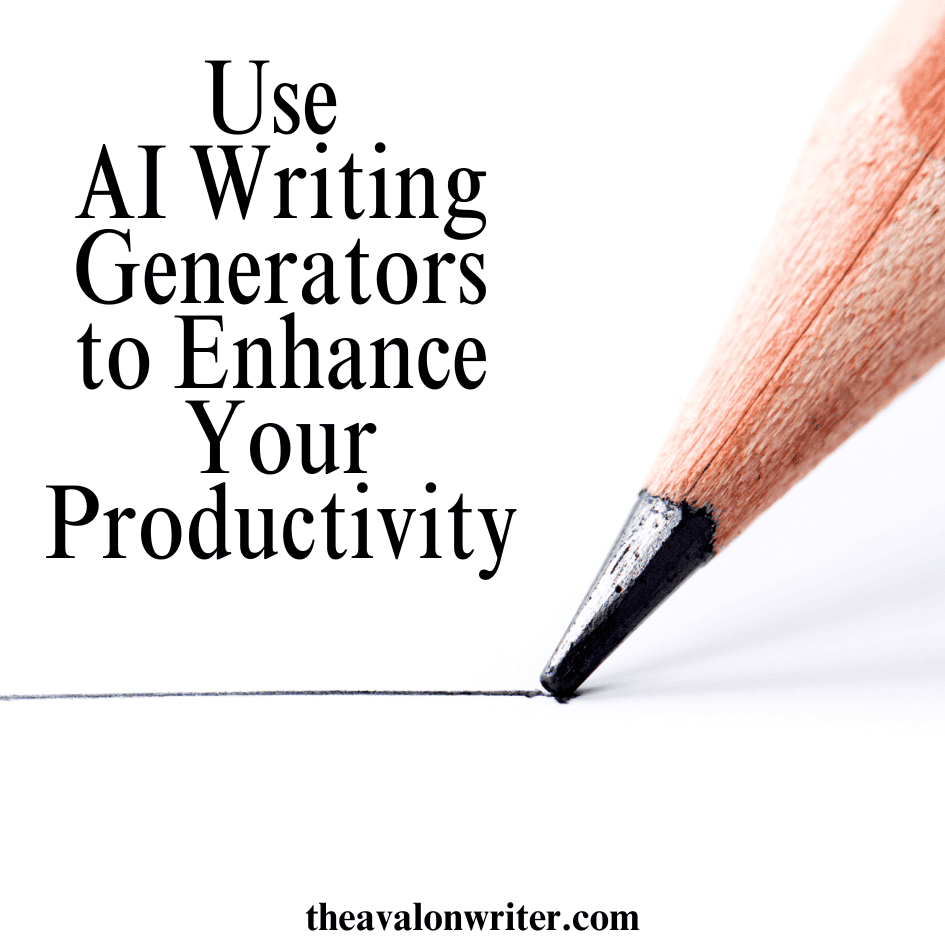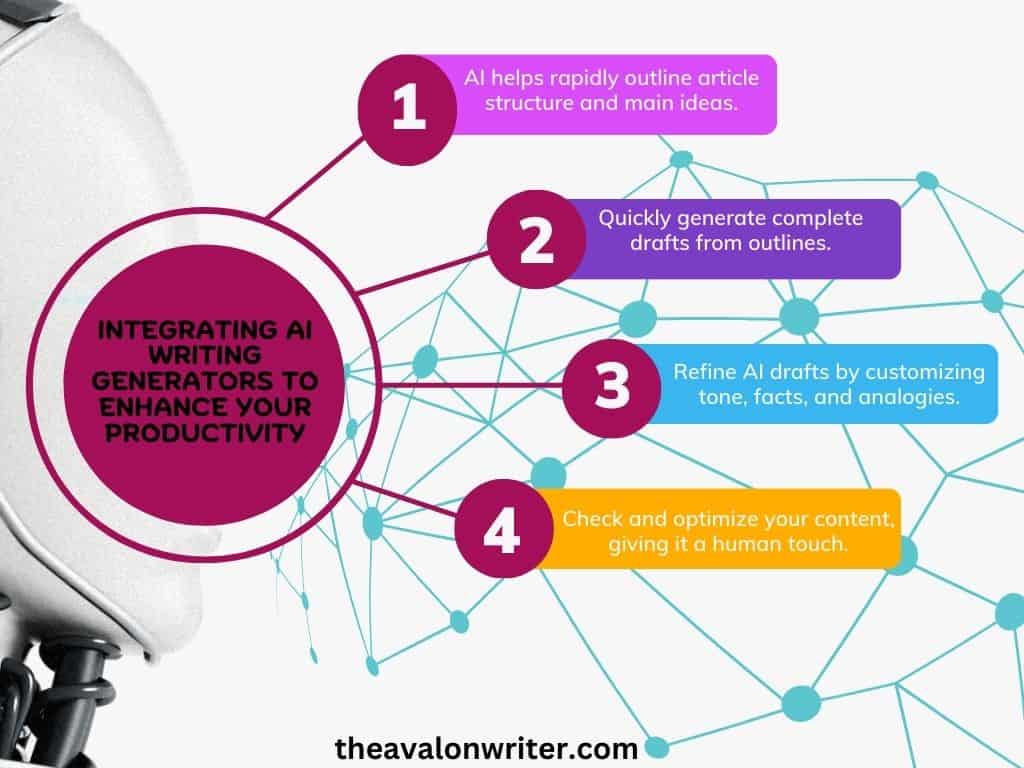How to Use AI Writing Generators to Enhance Your Productivity

Introduction
I have written for over a decade and know the agony of struggling to get the right draft for your client or starting an article.
In this article, I’ll share my hands-on experiences using the latest AI programs – the best AI essay writer, AI tools for writing, and the finest AI paraphrasing assistants. Whether you’re writing for business, academics, marketing or for fun, AI assistants can help generate ideas, rewrite drafts, boost originality and bring your words to life.
By incorporating these AI technologies, you can harness their power to enhance all aspects of your writing process – from research to editing. I’ll showcase techniques for seamlessly blending AI collaboration into improving your productivity.
5 key takeaways for leveraging AI writing assistants
Key takeaway 1: AI tools can create drafts on any topic, ensuring you always have writing ideas and inspiration.
Key takeaway 2: The best AI paraphrasing tools rewrite and enhance your text quickly without losing context or voice.
Key takeaway 3: AI writing generators boost creativity ideation and eliminate writer’s block through continually refreshed ideas.
Key takeaway 4: AI streamlines research by rapidly aggregating sources, summarizing key insights, and extracting quotes and facts.
Key takeaway 5: Integrating AI writing assistants into your workflow saves hours, allowing focus on strategy, messaging and connecting with readers.
Leading AI Writing Tools to Streamline Productivity
With the latest advances in artificial intelligence, various writing tools can amplify your productivity.
From AI programs that rephrase blocks of text in seconds while maintaining context and tone to imaginative writing aids that stimulate ideas and assist creative writing to essay generators that produce high-quality draft compositions on demand – writers have only begun tapping into the potential of AI collaboration.
By effectively integrating the right AI writing assistants into your workflow, you will gain access to an ever-refreshing fount of creativity.
Key Benefits Writers Get from AI Writing Productivity Tools.
The advent of AI writing assistants has unveiled transformative possibilities for the modern writing landscape. These emerging technologies enable authors to boost quality and accelerate the pace of writing like never before.
By setting the right prompts, integrating researched facts, and capitalizing on the creative ideological ability of language models, writers gain versatile on-demand support. The key is knowing how to properly collaborate with AI to amplify your strengths while compensating for current limitations in these tools.
With the right level of human guidance, AI can uplift almost all aspects of writing– from ideating outlines to improving stylistic flows.
The table below summarizes a few key upsides and potential downsides to be aware of.
| Benefits | Drawbacks |
| Saves a lot of time | Posssible chances of losing context |
| Quality of writing is improved | It may need heavy editing |
| Enhances your creativity | Still improving on its capability |
| More output and productivity | Struggles with being accurate |
| Ability to rephrase content fast. |
Save Time and Increase Productivity
In my experience, AI writing tools allow me to write more in less time. Studies show writers who work with AI write over 50% faster. AI tools shorten long research materials into short summaries in seconds. This gives me extra time to focus on important tasks and networking. By helping with the busy stuff, AI saves time and boosts how much I can accomplish daily.
Generate High-Quality Drafts
As a writer, I often use AI assistants to help me write good first drafts quickly. These tools use the latest AI to write clear, logical, full drafts on any topic in minutes.
One study found that essays written by AI scored as well as human writers for organization, reasoning, and factuality. By letting the AI write drafts, I can share more high-quality content faster than I could.
Rephrase Content Quickly,
I rely on QuillBot to rephrase and enhance some of my content. This AI rephrasing tool rewrites documents in seconds while preserving tone and meaning.
Recently, I had QuillBot rewrite a lengthy report to create more unique versions. The AI-generated five perfectly polished, properly cited copies of the full report in less than a minute.
QuillBot saves me hours I’d spend reworking text. The AI handles rapidly repurposing content in new ways at an unbelievable speed.
Stimulate Creativity and Ideation
As a writer, I use Copy AI. I am impressed with how fast it gives me good information on any topic I choose.
Recently, I used Copy AI to research emerging blockchain trends for a client article. It found current blockchain statistics and industry leader quotes from reputable sources online. Then, it wrote them into a nicely formatted and concise draft article, citing sources properly.
The data Copy AI found was more specific and credible than I could find myself searching.
AI makes research hands-free for me. It perfectly gathers and incorporates quality information to enhance my writing.
Best Practices When Working with AI Writing Generators
Key Takeaways:
- Set clear instructions so your AI assistant understands your writing goals.
- Carefully review AI drafts to fix mistakes.
- AI helps write faster, but you guide quality (human touch).

As an editor, I constantly work with writers collaborating with AI tools as part of their creative process. AI empowers authors to boost productivity, ideation, and output quality when used properly. However, effectively integrating artificial intelligence does require following best practices.
Through my extensive experience guiding writers of all levels on AI adoption, I have observed critical techniques determining whether AI speeds up and strengthens writing or creates more problems to fix. In this section, I will distil key lessons on the right way for writers to leverage AI assistants.
By properly establishing prompts for your AI tool and then rigorously reviewing and editing all AI output, you ensure healthy AI augmentation that uplifts your skills instead of relying on them as a crutch. The best practices include setting strong directives so the AI understands the writing objectives, maintaining human oversight for errors, and using AI responsibly.
Establish Clear Prompts and Parameters
When I first started using AI writing assistants, I would just put any idea down and create confusion about what I needed. Now, I have learned to give the AI very specific instructions so it can help speed up my productivity.
Setting clear goals and limits focused on my needs ensures the tool understands. This keeps the output on track and of high quality. Taking the time to frame precise prompts is essential for the AI to boost my productivity.
Review and Edit the Output
When I first used an AI writer, I assumed everything it created was perfect. Quickly, I noticed errors that needed fixing. Now, I rigorously review all content my AI produces before publishing. Editing the drafts helps me catch mistakes in facts, tone, and structure that the AI misses.
As a human writer, I must control the quality and viewpoint, even if AI writes the initial draft fast. Prioritizing this oversight ensures my viewers receive high-value content powered by AI efficiency but guided by human discernment.
Use Ethically and Responsibly
You should check each program’s license terms as an author using AI tools. All usage guidelines must be followed legally and ethically. Even free or purchased software has rules to respect ownership. Never claim that AI-generated content is solely your creative output.
Make it clear when sharing writing with stakeholders if you received assistance from artificial intelligence. Ensure your unique skills and perspective always guide the work rather than just delegating fully to AI, no matter how convenient. Be honest about how much automation helps create final products faster. AI should amplify your human talent, not replace needed diligence and care.
Integrating AI Writing Generators to Enhance Your Productivity
Key Takeaways:
- AI helps rapidly outline article structure and main ideas.
- Quickly generate complete drafts from outlines.
- You can refine AI drafts by customizing tone, facts, and analogies.
- Check and optimize your content, giving it a human touch.

Integrating AI tools into my workflow has been a game-changer as a writer. My productivity has skyrocketed with the ability to help outline ideas, write draft passages, and refine my work. My clients have been thrilled with how quickly yet thoughtfully I can produce content.
The AI tools help me organize my thoughts to overcome writer’s block, generate fresh ideas and angles, and align concepts into coherent narratives. I provide the AI assistant with a topic and parameters, and we efficiently collaborate to create polished drafts.
Integrating artificial intelligence into my writing process has made me more productive. This has allowed me to focus on strategy and creativity. I couldn’t imagine working without such a capable writing partner.
Outline and Plan Content
The first step I take when starting a new article is to map the structure and flow. In the past, it could take me hours to outline key points and topics. Now, with the help of AI tools like Writesonic, Copy AI, and Contentbot AI, drafting detailed outlines is fast and simple.
These tools allow me to input a few parameters. Within seconds, they generate customized outlines covering the main ideas, support points, statistics, examples, and conclusions – everything I need to start writing. I especially appreciate how they cluster related concepts so I can see logical groupings.
Rather than racking my brain to recall relevant facts and data, the AI pulls it all together. This gives me a solid foundation where all the pieces connect. With just a click, I have an organized content plan to build on. It would have taken much manual effort to craft such comprehensive outlines myself.
The AI doesn’t write the full article drafts for me. However, handling the outlining process saves me time planning and structuring content. This efficiency allows me to focus energy on writing original analyses and commentary within the framework mapped out. AI makes the initial planning stage easy, letting me concentrate on quality writing craft. It’s the best of both worlds!
Produce Drafts
Once I have a solid outline, I will transform those plans into full article drafts. This is where writing assistants like Writesonic, Charley AI, Koala AI, Copy AI, and Contentbot AI really shine. Rather than staring at a blank page and struggling to translate ideas into text, I can instantly generate rough drafts with just a click.
I simply feed my outline into one of these AI tools. They analyze the content plan and research materials in seconds to produce complete drafts covering every section. They even vary sentence structure and include transitional phrases between paragraphs. You can adjust the brand tone to help you present your article in your tone.
The quality varies based on my set parameters, but I can quickly generate several versions to compare. In the time it would take me to squeeze out a few paragraphs manually, I have multiple fleshed-out draft options. The AI tools become a drafting machine, translating outlines into fully readable content.
Of course, the drafts still need my human touch. I go through to customize phrasing, deepen analysis, spice up analogies, and apply final polish. But not having to labour over initial paragraph-by-paragraph drafting is an enormous advantage. AI gives me a strong foundation to take to the next level based on my writing skills.
Refine and Finalize
After drafting written pieces, I devote considerable time to refining and polishing – taking good content and making it great. AI tools have become invaluable assistants in elevating my work before final publication.
I begin by running my draft through the Surfer SEO software. It scans for opportunities to optimize keywords and formatting for search engine visibility. I also leverage Copyscape, which compares my text against current web content to catch any accidental plagiarism. Tools like Grammarly then check for hundreds of grammar issues I might overlook.
I can also utilize Claude’s AI detection capability to identify any biased, toxic or inappropriate phrasing. This helps me keep content search-friendly and helpful. The AI gives me a second set of eyes, red-flagging anything potentially problematic in my work.
I can streamline editing with these AI helpers’ surfacing improvement opportunities. Rather than painstakingly combing through drafts multiple times, I get an instant comprehensive review. This allows me to rapidly refine sentence structure, usage, pacing, tone and more based on the objective AI feedback.
Conclusion
Seeing my articles transform from rough outlines to finely tuned final works is incredibly fulfilling. Integrating AI tools into my writing process accelerates efficiency at every stage – outlining concepts, producing drafts, refining language and structure, and optimizing formatting. These assistants handle rote technical tasks rapidly, freeing me to focus on original analysis reflecting deep subject-matter expertise.
The combined strengths of human creativity and machine precision allow me to deliver thoughtful, engaging content extremely quickly compared to traditional manual methods. By leveraging artificial intelligence to complement my skills, I can strike the ideal balance between writing craftsmanship and productivity.
This fusion propels my workflow to the next level, enabling outstanding client outcomes. Though initially hesitant to incorporate AI, I’ve seen tremendously positive impacts. I truly couldn’t imagine working any other way now.
FAQ
How can I use AI to help with my writing?
>Outlining structure and ideas
>Producing complete drafts rapidly
>Rewriting and enhancing passages seamlessly
>Optimizing syntax, tone and formatting
>Stimulating creative thought through prompts
Establish precise directives so the AI understands goals. Review all output for errors before finalizing. Follow ethical usage guidelines.
How can AI be used to increase productivity?
AI writing assistants can increase productivity by automatically handling time-consuming rote tasks like drafting passages, aggregating research, paraphrasing content, and providing editing suggestions.
This lets writers focus on high-value work only humans can accomplish, including directing strategy, applying creativity, and ensuring final content quality.
Studies show properly integrating AI allows individuals to increase daily writing output by over 50%.
What are the benefits of AI text generators?
>Writing full drafts on any topic within minutes
>Incorporating up-to-date facts/statistics instantly during research
>Paraphrasing paragraphs without losing context or style
>Broadening creative boundaries through fresh connections
>Providing structural suggestions and editing recommendations
How can AI improve workflow?
The right AI tools simplify planning outlines, accelerate initial draft writing, rewrite paragraphs seamlessly, refine technique/style efficiently through feedback, and optimize final submissions. This expanded capacity at every workflow stage allows greater output with less effort.
Humans guide; AI executes.
How do you use AI writing generators?
First, establish clear goals and limits so the AI understands needs precisely. Input relevant research materials, prompts and keywords as starting points.
Generate multiple drafts to compare, then rigorously review and edit all output to catch any lingering errors, ensure accurate facts, customize tone/voice, and apply human discernment before finalizing or distributing.
Can AI improve your writing?
It is evident that when AI is properly applied, it can significantly improve the following:
>Idea generation and research aggregation
>Drafting efficiency and output volume
>Passage originality via effortless rewriting
>Revision ease through instant editing suggestions.
However, quality outcomes still rely on human discretion and oversight. AI should augment, not replace, indispensable creative and analytical skills.





